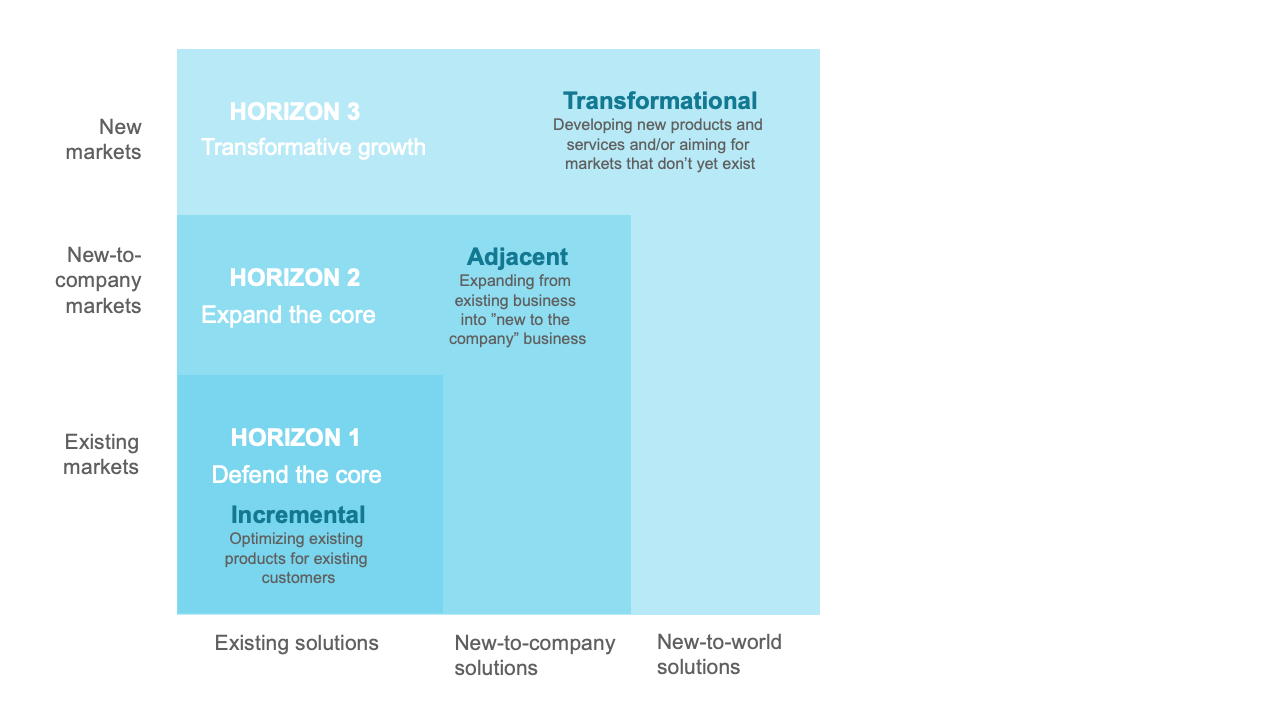Future-driven Innovation – Does Your Innovation Map have Three Horizons?
In traffic, you look ahead and adapt to what is coming. When you run, you scan the terrain to plan your steps. Our ability to anticipate and analyze change helps us navigate a changing world – and the same principle applies to innovation.
At Kairos Future, we create value for our customers every day through systematic innovation management based on business intelligence and foresight. We call it future-driven innovation. In this first of three articles, you'll get off to a flying start by learning how to meet your customers' growing expectations with a balanced innovation portfolio.
The power is in the simplicity. Whether you're a leader, entrepreneur or strategist, you'll gain insights and tools that can be immediately put into practice.
Innovation is not uniform – and that's a problem
It's easy to think of all innovation as the same. Innovation as innovation. But this simplistic view can lead to imbalance: faster, low-threshold innovations are rewarded, while longer-term, resource-intensive projects risk being overlooked.
The consequence is that organizations get stuck refining what they are already doing, while the innovation they really need - the one that creates long-term growth and renewal - is missing.
To address this, innovation efforts should be structured around market and technology renewal. One proven approach is the Three Innovation Horizons framework, which helps organizations allocate their resources strategically and create sustainable success1.

Figure 1: The innovation horizons. Click on the image to see it in a larger format.
The three innovation horizons
The innovation horizons are based on the recognition that different types of innovation require different processes. The level of innovation is assessed on the basis of market and technological innovation and can be divided into three main categories:
Horizon 1: Improving Existing Operations
Horizon 1 is about incremental innovation - small and frequent improvements to products, services, and processes that are within the organization's core competencies. Horizon 1 innovations typically make the product a little faster, a little thinner, a little lighter, a little cheaper, a little tastier, etc., and all build on existing offerings. The focus is on rapid introduction of changes that maintain competitiveness and respond to immediate market needs. A linear innovation process with streamlining and optimization at its core fits here.
Horizon 2: Extending the core business
The second horizon includes innovation that explores new markets and customer segments, revenue models, and technologies. It uses existing knowledge but with a new approach. The innovations are often broader than those in Horizon 1, but they are built on a solid foundation. Take Coca-Cola, for example, which dared to question its own formula for success in the face of a growing number of health-conscious consumers. The result was Coca-Cola Zero - the same familiar soft drink, but without the sugar. Or Impossible Burger, which launched the first meat substitute based on its nutritional research. Another example is Tesla, which realized that its expertise in battery technology for electric cars could solve an entirely different problem - the need for energy storage in homes and businesses. This insight led to the creation of the Tesla Powerwall.
The key to success is an agile approach where the familiar meets the innovative.
Horizon 3: Radical and disruptive innovation
Horizon 3 is about breakthrough innovations that can reshape entire industries and create new markets. Here, technologies and business models are developed that do not yet have an established market. The process is iterative and uncertainty is high - but the ability to learn quickly is critical to success. Examples include OpenAI's ChatGPT, which revolutionized the way people interact with technology overnight.
Other examples of radical and transformative innovation include:
- Decentralized financial systems through blockchain-technology
- Autonomous vehicles transforming cities and transportation
- CRISPR enabling precise changes in DNA
- The electrification of vehicle fleets impacting entire infrastructures and technologies.
Finding the right balance in your innovation portfolio
By allocating resources between the three horizons, you can ensure both short-term profitability and long-term renewal. In analyses of the resource allocation of successful companies, a common distribution is2:
- 70% in Horizon 1 (improving existing operations)
- 20% in Horizon 2 (extending the core business)
- 10% in Horizon 3 (radical and disruptive innovation)
The distribution is naturally industry-dependent where more agile sectors with simpler offerings need more resources in H1 compared to more technology-heavy industries that need to invest more in Horizon 2 & 3. Common to all industries is the need to work in parallel with innovations in all horizons.
Take the step!
Getting started with the innovation horizons is easy. Map your ongoing innovation projects by assessing their market and technology renewal and place them in a horizon model like the one above. This gives you a clear picture of the current situation and a strategic basis for adjusting the balance. The result is an innovation portfolio that systematically matches customer expectations and market demands for innovation.
Want to know more?
Future-driven innovation is Kairos Future's methodology for transforming business intelligence into concrete innovations with business value – even in challenging times. By starting with the changing world rather than the limitations of the internal world, sustainable innovation for the future is created.
In part two of this series, we describe how to identify the most promising areas of innovation for your organization based on the changing world. We call these future-driven hunting grounds.
Do you want to learn more about future-driven innovation? Contact Magnus Bergendahl, Senior Consultant with a focus on innovation and the future.
[1] Baghai, Mehrdad, Stephen Coley, David White. (1999). The alchemy of growth. New York: Perseus.; or Curry, Hodgson (2008). Seeing in Multiple Horizons: Connecting Futures to Strategy, Journal of Futures Studies
[2]Se Baghai Coley and White; Terwiesch and Ulrich; Naghi and Tuff; Gartner
